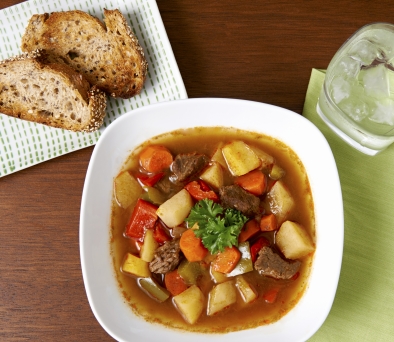
Selected by National Geographic as one of the "Top Ten National Dishes of the World." Like many national dishes, Hungarian Goulash has humble origins connected to rural life of days gone by. Goulash is basically a beef (although pork is also traditional) soup that is uniquely flavored by the generous use of paprika, which could be considered the national spice of Hungary.
The predominant ethnic group in Hungary are Magyars (92% in 2001) and it is the preferred term of self-identification. Goulash is called Gulyás in the Magyar language and the term means "herdsmen." Although the number of cattle in present day Hungary is much lower than what is found in neighboring countries, in 1895 there were nearly 6 million head of cattle (8 times the present number) and herding and the raising of livestock was a primary economic activity. Today the Hungarian Grey cattle (which have formidably large horns) are more often seen in zoos and national parks than in the countryside; in 1975 there were only about 300 Hungarian Grey cows left in Hungary. It is postulated that the symbolic importance of goulash, establishing the Magyars as a distinct ethnic identity, came under the flourishing of Hungarian culture and arts through the rise of the Austria Hungary empire. After the defeat of Austria Hungary in World War I, Hungary lost more than 2/3rds of its territory.
Paprika is a major ingredient in Goulash. Paprika is a powdered spice made from a particular kind of sweet red pepper (Capsicum annuum), commonly referred to as a Bell Pepper. Hungarian paprika comes in many varieties that range from sweet to spicy and is sometimes smoked (although smoked paprika is more common in Spanish cuisine). Until 1920 most peppers were hot peppers until a grower in southern Hungary (Szeged) discovered and propagated (through grafting) a sweet variety. Sweet paprika is made from de-seeded fruits but spicier versions include seeds or are enhanced with a hotter pepper like cayenne. Today, paprika from the Szedged region is considered to be the finest in quality. In 1937 Hungarian physiologist Albert Szent-Györgyi de Nagyrápolt won the Nobel Prize in Physiology or Medicine for, among other things, discovering Vitamin C. Bell peppers, from which paprika is derived, have the 3rd highest Vitamin C content in natural foods, only bested by hot peppers and guavas. Indeed 100 grams of raw sweet red peppers has 213% of the daily recommended value for Vitamin C (yellow peppers have even more), more than twice that of the same amount of a typical orange. Hungarians distinguish at least 8 different varieties of Hungarian paprika. Goulash typically is made with sweet Hungarian paprika, but of course the restless cook is free to experiment.
Goulash recipes vary from cook to cook. The required ingredients are beef (or pork, lamb, and one wonders if tofu could be managed), onions, paprika and water. However many recipes call for the use of fresh green or red peppers, tomatoes, diced potatoes, carrots, parsnips, kidney beans, sauerkraut, caraway seeds, bay leaf, thyme, garlic, wine, vinegar, "pinched" flour dumplings (csipetke) and/or pasta. There is one variety known as "American Goulash" popular in the Midwest that is baked as a casserole and may include lots of tomatoes, elbow macaroni, corn, kidney beans and/or processed cheese. It is also sometimes made with ground beef instead of slow cooked cubed meat.
Hungarian Goulash is typically eaten out of a bowl and accompanied by rustic bread. It can also be served over egg noodles (best are German or other European egg noodles!). Using Hungarian paprika is downright essential (fortunately it is sold everywhere). This recipe can also be prepared in a slow cooker or crock pot, just remember to brown the meat first to be able to enjoy the result of the Maillard reaction (if you don't know what that is, look it up!).
Ingredients:
- 2 pounds cubed stewing beef
- 2 tablespoons light olive oil (not extra virgin) or other high-temp cooking oil
- 2 medium onions, chopped finely
- 3 tablespoons sweet Hungarian paprika
- 4 carrots, peeled and cut into 1/2-inch rounds
- 4 medium new potatoes, peeled and cut into 1-inch cubes
- 1/2 teaspoon caraway seeds
- 1 green bell pepper, seeded and cut in 1/2-inch pieces
- 1 red bell pepper, seeded and cut into 1/2-inch pieces
- Cooked rice, egg noodles or csipetke dumplings (optional)
- Salt to taste
Preparation:
- In a large soup pot or Dutch oven, saute onions over medium-low heat, stirring frequently, until translucent.
- Turn the heat to medium-high and add the meat cubes and brown on all sides.
- Stir in the paprika.
- Add sufficient water to cover the meat.
- When the pot comes to a boil, turn the temperature to low and cover the pot.
- Cook for 1 1/2 to 2 hours (until the meat is tender).
- Add caraway seeds, green and red peppers and potatoes and cook until the vegetables are tender.
- Add water if necessary.
Serve over rice, egg noodles, csipetke dumplings or with a rustic bread.
Recipe by T. Johnston-O'Neill
Photo by Heidi Adams








